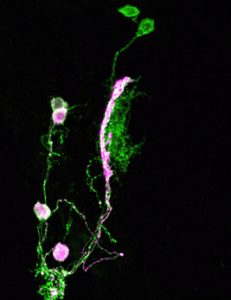
Sun and moon. Sun and moon. Time goes.
John Updike, Rabbit Run.
The predictable progression of the seasons and the incessant oscillation between night and day have left a deep impression on all living things. The living world resonates with the Earth’s clock-like movement through space. Most creatures, from humans to cyanobacteria, maintain endogenous molecular time-keeping mechanisms called circadian clocks that serve as models and measures of time’s passage. These living clocks orchestrate countless daily and seasonal changes in physiology and behavior that anticipate the predictable and often severe fluctuations of the environment.
Work in the Shafer lab seeks to understand how networks of clock neurons orchestrate rhythmic behavior. The fly Drosophila melanogaster has been a valuable model system for the molecular and neural basis of circadian timekeeping. The fly’s molecular clock is built of a small group of genes with high homology to those of mammals. Furthermore, the neuronal basis of timekeeping also appears to be based on similar building blocks throughout the animal kingdom. The Shafer lab employs anatomical, genetic, and live-imaging techniques in Drosophila to discover how time is kept within the brain and how it is used to orchestrate daily and seasonal changes in behavior.
